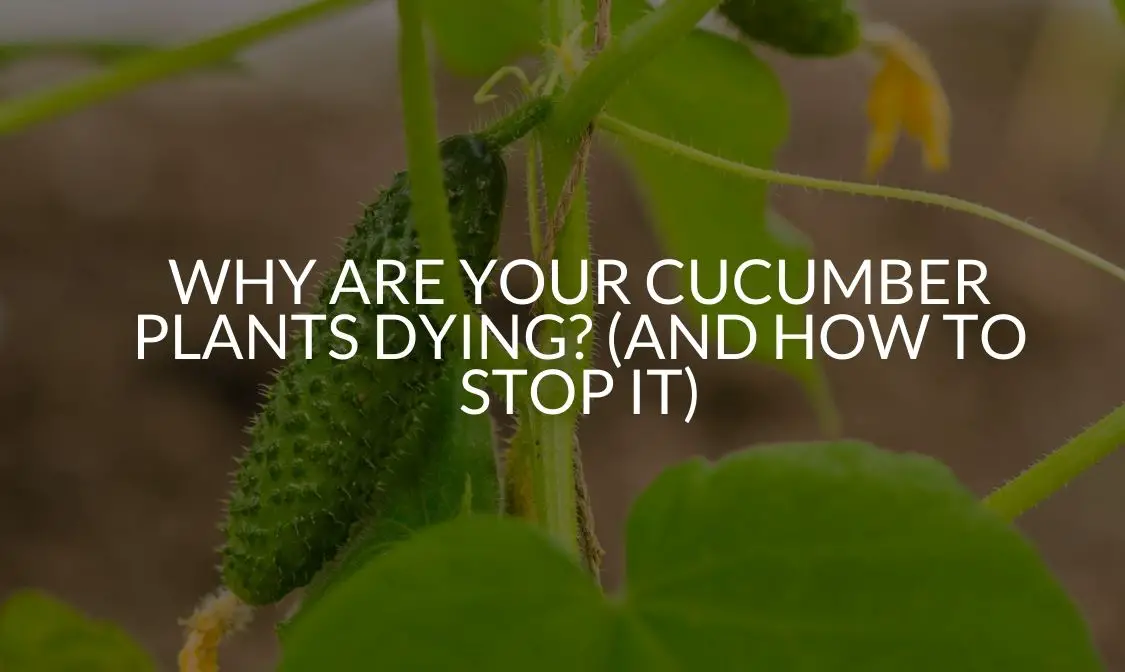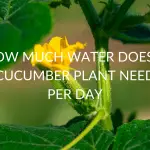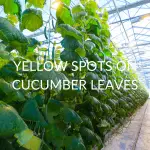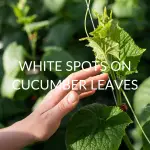Cucumber plants are susceptible to several different types of pests and diseases. Pests such as aphids can leave your cucumbers deformed with white patches on their leaves after sucking sap from them. Other problems like powdery mildew are caused by fungi spores that find moist, cool conditions to thrive in.
Without ample water or fertilizer, cucumber plants will die from insect infestation, fungus, or the plant’s inability to produce enough chlorophyll (green pigment) as it becomes stressed.
In this article, we will discuss a few of the various reasons that may cause your cucumber plants to die and how to avoid them. Additionally, we’ll go through why common issues occur and how to revive your cucumber plants if you notice specific symptoms.
Why Are Your Cucumber Plants Dying And What Can You Do To Stop It?
As a cucumber gardener, you’re going to want to take steps towards improving the health of your cucumbers, including better watering practices, using natural pesticides for insects, and fungicides for disease prevention.
The cucumbers are a member of the gourd family, and as such, they’re susceptible plants that require near-perfect growing conditions if you want to succeed with them. They love moist soil but don’t like it when it’s too wet – which is where root rot comes from- so make sure your garden bed is well-drained and not overwatered.
Cucumbers need lots of nutrients for their vines to grow rapidly, including:
- Potassium
- Magnesium
- Calcium
- Phosphorus
- Nitrogen, all found in manure fertilizer.
For insect control, try using neem oil on the leaves before blossoms form, while fungus prevention includes coating cucumber plants with a light layer of oil which helps repel cucumbers from cucumber wilt disease.
Pests
Pests can kill cucumber plants by attacking them from above or below ground level. To make sure your garden is pest-free, it’s essential to identify what type of pests you have and how they attack their prey so you can know the best way to stop them.
Some common pests that can cause cucumbers to die are:
- Cucumber beetles
- Cucumber thrips
- Moths
- Squash vine borers.
For cucumber plants not to succumb, you should identify what type of pests they have and how they attack their prey so that you can better protect your cucumber plants from being attacked.
When it comes to pest control, it’s essential to recognize which bugs are attacking cucumber plants so that you can determine if there is any specific insecticide needed, such as neem oil for beetles and thrips.
At the same time, sulfur will work against moths and borers. It’s essential to understand cucumbers’ natural predators and what they look like so that you can avoid replanting cucumber plants in the same area if pests are overgrowing them.
Cucumbers are more prone to being damaged by insects than other vegetables because they have an unusual shape with lots of leaves for eggs or larvae to hide in, which makes them challenging to spray pesticides on while also avoiding the cucumber itself.
If the cucumbers show signs of wilt (leaves became brown), then it is likely due to an infestation that will most likely spread if not taken care of quickly, such as aphids (plant-eating bugs). To control, this issue uses insecticidal soap spray on cucumber leaves which suffocates these pests rather than kills them outright like pyrethrin.
Diseases
Cucumber plants are also vulnerable to cucumber mosaic virus, a prevalent disease spread by cucumbers themselves and can cause yellow streaks on cucumber leaves or even their fruit which will be smaller than normal misshapen features.
To prevent these types of problems, it’s important to take good care of your cucumbers, including providing them with plenty of water while avoiding giving them too much nitrogen-rich fertilizer as this can lead to excess leafy growth at the expense of fruiting vines.
How to Prevent Cucumber Diseases:
- Keep soil moist but not wet and well-drained by adding lots of manure or compost tea for nutrients.
- Use neem oil on leaves before blossoms form as an insect repellent while coating cucumbers in vegetable oil to prevent fungus growths (cucumber wilt and powdery mildew).
- Plant cucumbers are at least 16 inches apart, so they don’t compete for sunlight, water, and other space requirements.
Cucumbers need to be planted in well-drained soil moist but not wet because cucumbers do not like soggy soils. They also need a lot of nutrients, so adding manure or compost tea can help the plant grow more quickly and prevent cucumber diseases from occurring.
Cucumbers Turning Yellow And Dying
There are various reasons your cucumbers may be turning yellow and dying, including a lack of nutrients or overwatering. Any of these common issues can cause your cucumbers to present symptoms, but there are ways to fix them before your plants die completely.
Some common problems cucumber plants can experience include:
- Dying cucumbers due to inadequate amounts of nitrogen in the soil.
- Wilted leaves as if they could be suffering from insufficient potassium levels.
- Cucumbers suffer from diseases that can spread quickly amongst other plants.
There is no one solution to solve these issues. Still, you can increase water flow while keeping it drained and, at an optimum level, use cucumbers as a barrier from cucumber plants that are affected by the diseases.
Lack of Nutrients
If cucumbers aren’t given the right amount or type of nutrients, they may start turning yellow and dying off. However, it’s important to make sure you don’t overdo the fertilizer in cucumber plant beds. Otherwise, they could die too because of excess nitrogen levels that can cause yellowing leaves.
Plants may also suffer from nutritional deficiencies such as magnesium in soil or calcium deficiency because the plant lost its ability to absorb nutrients through transpiration due to wet weather conditions for too long. The plant might experience the cucumber mosaic virus, which cucumber beetles transmit.
Cucumber plants require adequate water and fertilizer; cucumber plants need about one cup each week for plantings from April through October. If cucumbers look wilted, they might have heat stress and require more frequent watering.
Use A Fertilizer
It is important to ensure cucumber plants are given the right amount of water and fertilizer with not too much nitrogen, as this will cause yellowing leaves. Most cucumber plants will need a high phosphate, which is needed for photosynthesis, and also potassium.
Overwatering
Soluble salts (which come with water) may build up on cucumber roots over time if the soil isn’t draining properly due to heavy rain or flooding. This causes cucumbers not only to turn yellow but begin drooping down like wilted vegetables.
Correct Any Drainage Issues And Avoid Overwatering
The best way to fix these issues would be by adding sand into cucumber soil and improving drainage. Be sure not to over-water your cucumber plants. Feel the soil at a one-inch depth, and if it is wet, don’t water them. Always be sure to use fresh water when watering your cucumbers.
Mildew Disease
If cucumbers have black spots on their leaves, they are most likely suffering from a mildew disease. This will eventually cause cucumbers to wilt away and turn yellow before dying off altogether.
The most common cucumber diseases are mosaic virus (causes yellowing), angular leaf spot, bacterial wilt, downy mildew, powdery mildew, blight organism Xanthomonas campestris PV (associated with slugs), whiteflies, and spider mites.
If it is a cucumber disease, then the cucumbers will not grow, and if they do, they will be misshapen or of poor quality and should not be eaten. One way to combat this issue is by creating a three-foot “halo” around cucumber plants to discourage cucumber-eating pests.
Soil should be prepared before cucumbers are planted with well-rotted manure or compost, mixed into a depth of three feet.
Provided you followed these guidelines for planting your cucumbers, there could be one of two reasons why cucumber plants might still be dying: diseases or infestations such as aphids (plant-eating bugs).
Prune Diseased Cucumber Plants
The best way to fix these issues would be by cutting out all of the infected parts of the leaf-like dead edges where mildews could reside and poking holes into each spot you see with a needle (to allow airflow) until it is healed.
Moistureless Area/Cucumber Overheating
If cucumbers are being grown inside or near windows with no natural wind flow to cool them off, they may end up overheating very easily since not enough moisture can escape from their leaves. This causes plants to wilt and turn yellow before dying off completely.
Cucumbers left in direct sunlight for too long usually show signs of overheating and dying off. Cucumber leaves are covered with a water-repelling wax layer which prevents them from losing moisture through their stomata when plants get hot too quickly.
Avoid Direct Sunlight and Water Cucumbers Regularly
To avoid underwatering, water your cucumbers on a schedule of twice per week. If you notice signs of wilting, check the soil and add additional days if need be. Avoid planting cucumbers in direct sunlight. These plants only require around five hours of sunlight per day.
Cucumber Dying On The Vine
Cucumbers may be dying on the vine for a few reasons. Cucumber plants typically show signs of overheating and dying off when placed near open windows or grown inside where there is no airflow.
Sometimes cucumbers will still grow if they’ve caught sunburn because cucumbers can produce more wax to protect themselves, but this isn’t always enough to save them from eventually dying under these conditions again.
Cucumbers could likely be getting too much heat, causing excessive transpiration (the process by which water moves through a plant). This type of damage is irreversible, and cucumbers might die if given these conditions again.
Excess Heat and Sun Exposure
The cucumber plant does not like heat, so it’s crucial to keep cucumbers away from direct sunlight as much as possible. If you live in an area where there is excessive heat or humidity, cucumbers will
Cucumbers can be killed by too much sun exposure if they’re planted close to windows or grown inside without airflow. This could cause cucumbers to produce more wax which protects them from the damaging effects of UV rays but sometimes isn’t enough to save them indefinitely.
Cucumber plants need a lot of sunlight and do not like direct exposure to UV rays. This can cause cucumbers to heat up and wilt if too close to a window or grown in an area without adequate airflow with no access outside.
Even though cucumbers will grow indoors as long as there is enough room for them to stretch out, these conditions can lead cucumber plants to die if given too much time under fluorescent lights that imitate sunlight but don’t have the same wavelengths from natural sunshine.
Avoid Too Much Direct Sunlight
Cucumbers are a warm-season vegetable and should not be planted until the soil has reached at least 60 degrees. Cucumber plants will need about five hours of sun per day to grow cucumbers in conditions that would otherwise produce cucumbers.
To ensure cucumber plant health, it is important to make sure they have plenty of water, fertilization, sunlight, space from other vegetables or fruit trees, and good drainage.
Overwatering
Overwatering can cause cucumbers to die on the vine as cucumbers need less water than other plants. One way to tell if cucumber plants are getting too much water is by checking their soil.
If the top layer of soil feels moist and squishy, it’s time to give cucumbers a break from watering so they can dry out before being watered again. Otherwise, their roots will start becoming overgrown with fungus or algae that could lead cucumbers on the vine to die.
Avoid Overwatering
The key here is one thing: correcting your environment! Just because you can’t grow them outside doesn’t mean you’re supposed to stop trying. You’ll have more success in this endeavor when taking care of cucumber plants inside as long as maximizing light exposure.
Overwatering cucumber plants can also occur if there’s heavy rain or an irrigation leak that leads to puddles on top of the ground. If you have this problem with your cucumber plant, try transplanting it into drier dirt or use plastic mulch, so water doesn’t pool up around it.
It would be best to watch for signs that indicate too much watering, such as drooping leaves, yellowed leaves, and wilting stems.
Cucumber Seedlings Dying
If you notice cucumber seedlings becoming wilted and soft with droopy leaves or flowers, it’s time to give cucumbers a break from watering so the roots can dry out before being watered again.
Otherwise, cucumbers on the vine will start developing fungus or algae that could lead them to die! The key here is one thing: correcting your environment! Just because you can’t grow them outside doesn’t mean you’re supposed to stop trying.
Specific Cucumber Care
Some tips for caring for your cucumber plants include:
- Water cucumbers twice per week using the soil or hydroponic system’s reservoir (remembering not to overwater).
- Watering in the morning so you can keep an eye on them throughout the day without worrying about evaporating too much moisture out of them by evening.
- This is also helpful for plants grown outdoors as they’re more likely to dry before getting sprayed mid-day during summer months!
- If cucumbers are wilted, it means they’ve been over or underwater; this condition will last until roots have time to recover from being overly wet or dried out.
Wilts can also be caused by cucumber plants being grown in too much shade or direct sunlight, cucumbers that haven’t been hardened off to the sun gradually, and those with low potassium levels (potassium is needed for cucumbers to conduct photosynthesis).
Cucumber Soil pH
Cucumber seedlings need a pH of between six and eight, so make sure your potting soil or hydroponic reservoir has enough nutrients from fertilizer.
Adjust pH Levels
If you suspect cucumbers are suffering from inadequate amounts of potassium as their wilted leaves start appearing after transplanting outside, then add more potassium-rich compost around the roots.
Cucumber Leaves Dying
The wilted leaves started appearing after transplanting outside, but they can start showing up before this since cucumbers only grow about an inch per day on average. Cucumber leaves could die because cucumber plants are struggling to get enough sunlight, are getting too much or not enough moisture, or are just too hot.
Adjust the Environment
You may have cucumbers growing in a hot and dry location, keeping the soil too warm with not enough water to keep up with it all. If this is the case, you will want to move your cucumbers into a cooler area where they can grow taller before harvesting them for food!
Cucumbers are sensitive plants that need lots of moisture, or else their leaves will turn yellow and die from lack of nutrients. To avoid this, you can add a potassium-rich fertilizer or compost to the cucumber plant’s soil.
Put seeds directly into the moist potting mix in trays or pots, then place these on a sunny windowsill indoors (or outdoors if temperatures do not exceed 60˚F) until seedlings emerge. Keep soil evenly moist but never soggy.
If you notice your cucumber leaves starting to yellow or die, there’s no time like the present for some quick action – it might be too late already. You can give them more space by transplanting them to a cooler area where they will grow taller before harvesting them for food!
How Can You Revive A Dying Cucumber Plant?
To revive a cucumber plant with dying cucumbers:
- Maintain an appropriate amount of nitrogen in the soil/hydroponics
- Increase the water that provides enough oxygen for plants to thrive on.
- If cucumbers suffer from inadequate potassium as their wilted leaves start appearing after transplanting outside, then add more potassium-rich compost around the roots.
Reviving cucumber plants can be done in several ways. If you notice your cucumber plant showing signs of wilting or discoloration:
- Keep cucumbers well watered and in soil with good drainage.
- Move cucumbers to an area where they will receive the appropriate amount of sunlight for their needs.
- Remove any diseased cucumber plants from your garden or hydroponics system so that you are not spreading any disease among them.
There is not just one cause for cucumber plants dying, and there’s no one solution to solve the problem. Still, you can do things like increase water flow while keeping it drained and in an optimal amount or using cucumbers as barriers around cucumbers hit by the disease.
Should You Cut Dead Leaves Off A Cucumber Plant?
Careful pruning helps maintain a balance between vine growth and fruit production. Carefully cut back any dead, damaged, or excess portions from the cucumber vine uniformly throughout the growing season.
Cucumber plants have problems with cucumber diseases such as wilts and cucumber mosaic virus, which can cause cucumbers to wilt, grow yellow or purple spots on their skin while growing a lot of dead lower leaves during the process.
Wilting is also caused by lack of moisture, but it’s important not to cut off wet dead leaves because they protect cucumbers against pests like aphids who lay eggs at leaf nodes where there might be some dampness left behind after rainstorms when watering has stopped.
Recap
It’s crucial to know about cucumber plant problems and cucumber diseases, so it is easier to take care of cucumber plants properly. The more you learn about cucumbers, the better your product will be!
For example, with cucumbers, in particular, knowing how rain can contribute to cucumber disease or wilting could save a lot of time spent watering them after rainfall if they are wilted due to lack of moisture (not too much).
If there has been excess water on cucumber plants for an extended period from heavy rains, then remove as many dead leaves as possible. The weight of dead leaves or cucumbers causes damage that may lead to wilt or death of other parts of the plant.





